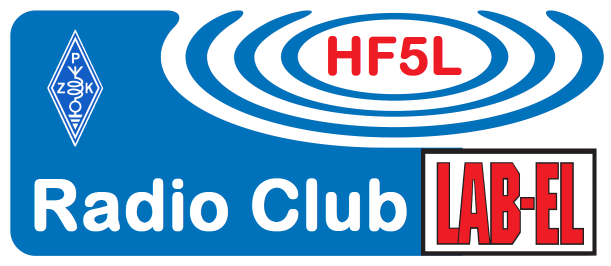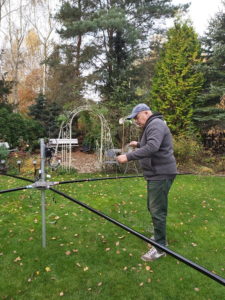As you know, I have been promoting QRP for many years, also in competitions. Unfortunately, until 2019, working in low-power competitions did not make sense due to propagation on the upper bands. In 2020 already I returned to QRP at CQWW.
Usually, I choose one upper band to sleep at night. And what is important to get a meaningful result? Of course the antenna!
So this summer I started studying my antenna potential on 14/21/28. The Butternut HF5B used was good, although it gave a relatively small gain compared to the InvVee or GP, so the question arose – what to put?
I have lived in a house with a garden for over a dozen years and rejected ideas such as tall masts or trusses. If I did, the antennas would be high and the garden would lose its beauty.
I was browsing the available antennas, so TH3JR and clones, hexbeam and spiderbeam. After a deep comparative analysis and the available place, I chose a spiderbeam of German production. The antenna is expensive as for the pocket of a young retired, but “you live once”!
When the package arrived, I was satisfied with the quality of the elements and started assembling in September. Once again, I was playing like a child. There was a lot of work, especially in understanding the next stages of submission. Despite the well-written manual, I found a few bugs and doubts. Summa summarum antenna was ready on the lawn on a short mast in mid-October. I bought it with unplanned gymnastics among many tubes, lines, wires and binders.
One week left until the competition and a “prayer” for the antenna to fit between the mast and the sloping roof. It turned out that I have a stock of half a meter. It’s good. So the antenna went up and when rotated by 360 degrees, it hit the InvVee arm at 80/40. So we had to move the wire away …
Cable, plug and VNA – first measurements showed great at 14 MHz and 21MHz. WFS and impedance were very good, but 28 MHz resonated at 29.6 MHz not reaching the minimum in the band. This is the biggest design error of the given dimensions, unpredictable even with a spare wire on the vibrator. So, it is to be corrected in the Spring.
So the choice of the band for the competition is 21 or 14. I chose the 20 m to improve my result from last year. The aim was to get as close to the European results as possible. Target is 300 QSO, 20 zones and 50+ countries.
On Friday I look at the SSN, A and K monitor – it’s great! I chose the non-assited category, I prefer to work in the good old S/P style.
On Saturday, as an early riser, I got up easily at 4 local time, made myself a cup of coffee and turned on the radio. The silence in the air. I’ve always loved that moment when propagation wakes up. And then suddenly I see a signal on the screen (Ftdx101MP) – it’s 9A4M on S9 +. And there is the first QSO in the log at 02:12.
Then silence until 03:30, where to my joy and surprise, stations from South America appeared. A bit unsure if I will make it, I called PP4T and he answered after 3rd time! That’s great, so I turn the knob and count more PY.
The stations with CX and HK can’t hear me, but … At 03:47 I do the first ZL, and then the next. Cheers of joy, respect for the “spider 6m above the ground.
Wow, I won’t get any further!
When the euphoria has subsided, I hear the D4L booming and do it the first time. Here is a digression about the work of QRP in contests, based on many years of experience. It is extremely important to feel the two elements.
The first element is a call as soon as the station arrives and there is no crowd calling out yet. Remember that our signal is weak and there is a chance if we call.
The second aspect is waiting patiently for a top of propagation from a given station. Sometimes you have to call out patiently, and when none of it works, it’s a waste of time. In CQWW competitions, the number of QSOs (especially for 3 points) is more important than the multiplier.
From 04:50 the normal fun started, mainly hunting for multipliers and scoring stations for 3 points.
The antenna showed its value – good front/rear and front/side attenuation, which is important in QRM. Directional gain much better than the 2-element Butternutt. But something did not work … I do not find out to many stations at all, eg JA3YBK, B0A etc. Well, but it’s time to do QSO, not think.
Opening to W/VE quite good – easy at the beginning of propagation, then more and more difficult. I ended the first day with 145 QSOs with the better result than in 2020.
On Sunday I looked at the monitor knowing that a magnetic storm was approaching. It’s not bad – ANN = 103, A = 5, so maybe the band will not go out, as it used to be.
I started at 04:11 doing mainly Russians from Asia. It got nice points. At around 6Z, Europa appeared, and then suddenly, with the antenna at 210 degrees, I heard VK3TJK on the S8. I already want to spin on LP, but the signal weakend at 270 degrees of the antenna. So I went back quickly to 210 degrees and here was the signal maximum again. I was calling out and … YEEEES! Double multiplier nice. However, the question arised – what about my new antenna?
When it got light I took my compass and saw that the antenna was set to 210 degrees, but it was actually 270 degrees! I turned it and in several positions there was still a difference between the pointer and the actual direction of the antenna. Turning north through east and everything was clear – instead of 0 degrees I had 060 degrees. Rotor stopped on end brake. That’s why I didn’t make a call to Japan and China on Saturday.
A quick look at the rotor instructions and you could see that I did not synchronize the antenna and indicator when placing the antenna. Well, I had to live with it until the end of the competition. As the propagation to the far east came, I turned the antenna west, north and north-east, and I passed and BY no problem.
And when I felt that W was about to come out, the antenna was already at 300 degrees, checked with a compass. More than a dozen W/VE stations appeared in the log. Interestingly, Europe was still not very active in this direction. And I was doing my job, a lot of new multipliers, including zones 8 and 9, which appeared for a very short time.
In the early afternoon, the conditions were a bit sluggish and I already had many stations on my log.
I felt tired and knew that I would not reach 300 QSOs anymore. The time for QRP is up, even though I heard many stations on S9, eg A61BR, HZ1TT etc. So I decided to end my activity around 17Z. The last station I called was SP8R for the multiplier. I listened with pleasure to him being called by zone 3, 4, 5. For me he was going to S9, but I didn’t reach.
So I close the station with no regrets and with a healthy throat. This is due to the M1 microphone with memories … hi.
I was satisfied with my result because I scored 3 times more points than a year ago. Of course, the propagation was not much better, but I hope that at least I will be the first in the SP and I will be in the top ten in EU.
Band QSOs Pts ZN Cty Pt/Q
14 254 391 20 62 1,5
Score: 32 062
73 de Włodek HF5WIM



Number of Comments: 1
Hi Wlodek, thanks for interesting story from the CQWW as QRP. QRP is not an easy task but worth it! I made nearly 400 contacts on 80m https://om0a.cq.sk/om0a/qrp-stretnutie-s-qro-v-cq-ww-dx-ssb-contest-e-2021/ using inv.Vee antenna and simple setup. CU in the next contest!